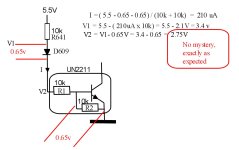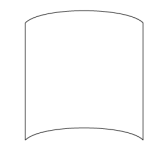Thanks for the reply Hugo.
Base-Emitter on Q203 is like 1.5V on a diode test, and the Base-Collector is a more expected 0.6V. That would suggest it's not behaving correctly. I guess it's toasted.
Not an easy transistor to get, and I can't find anything with the same hFE characteristics in the same maximum ratings. The original transistor is a 2SD1312/2SB984 pair, and they have an hFE of around 200 or so when driven at under 300uA. The highest hFE I can find at such a low current level is around 100 or so.
How important do you think hFE is for this application?

There is a slight drop on the collector of Q254, it's 23ish volts and the B and E are 24ish volts. I replaced it with a new part so it (and Q255) should both be fine.
Fascinating. Thanks for the explanation. I really love this kind of stuff and learning about how it all works. That part seems to be working correctly, but the voltage on one of the cathodes inside D609 (D609 is the one with two diodes inside) is too high. The output that leads to Q613 is only 2.7V when it should be 0.1V. I don't think it's coming from D608 though. I think the 2.7V has to be coming from Q613, right?
If only one of the three diodes is supposed to be conducting, then it stands to reason that the output of D608 should only be going to the cathode on the Q615's Base. The other diode inside D608 should be off and not contributing to the voltage on the Base of Q613.
So still then, I don't understand where that 2.7V comes from. Could the bad transistor Q203 be the cause of the lost 6.5V at the Collector of Q613, and that's making 2.7V appear at it's Base? I drew out the voltages on the logic to help myself try to understand what's going on.
There's supposed to be 25V on Pin 11 of IC250. I think this could maybe close the transistor input at Pin 6 and bring it to zero. That closes anodes of D255 and then zero volts appears at Collector of Q612. This causes 6.5V to flow through Base of Q612 and to the collector of Q613 and Pin 1 of IC604. Possibly make sense?
This is what I drew to try and visualize it:

If the V POSI signal really is 1.3V (and not 8.3V), the the emitter voltage of Q203 should be about 2V, if it is 8.8v (where you said "okay) then the base-emitter junction of Q203 must be destroyed as it has 7.5V across it in the fwd direction. Check Q202 as well and the fusible resistors.
Base-Emitter on Q203 is like 1.5V on a diode test, and the Base-Collector is a more expected 0.6V. That would suggest it's not behaving correctly. I guess it's toasted.
Not an easy transistor to get, and I can't find anything with the same hFE characteristics in the same maximum ratings. The original transistor is a 2SD1312/2SB984 pair, and they have an hFE of around 200 or so when driven at under 300uA. The highest hFE I can find at such a low current level is around 100 or so.
How important do you think hFE is for this application?

With all the voltages on Q254 being 24V, this suggests a defect in the V POSI 2 signal, that is supposed to be 7V and instead its 24V, that cuts off Q254 (if the transistor is working), so investigate that too. In the case that Q254 was cut off though, one would expect the collector voltage of it to be lower than 24V, as something should be sinking current to ground in the collector circuit, unless the cause of that fault is a totally shorted out Q254 could explain the measurements.
Probably Q255 is ok, but is base voltage the V Posi signal is simply too low.
There is a slight drop on the collector of Q254, it's 23ish volts and the B and E are 24ish volts. I replaced it with a new part so it (and Q255) should both be fine.
The diodes inside the digital transistor arrays with their cathodes connected to the common rail, normally the power rail, are to prevent the collector voltage of the transistors exceeding the supply voltage. In most cases it wouldn't in a circuit with passive components, but it can if say the transistors are used to drive a small inductive load like a small relay coil it can after the coil is de-energized.
Diodes D608's, D609 are wired as a form of OR logic gate where the diode with the lowest cathode voltage of the three, takes control of the common anode voltage, because by lowering the anode voltage it tends to take the other two diodes out of conduction. So the diode with the lower cathode voltage is the main "controller" of the voltage at the junction of the anodes. For example when D609's cathode gets grounded, it kills the current sourced by the two diodes of D608 and the 10k resistor from the 24V rail to the circuits that D608's cathodes feeds.
Fascinating. Thanks for the explanation. I really love this kind of stuff and learning about how it all works. That part seems to be working correctly, but the voltage on one of the cathodes inside D609 (D609 is the one with two diodes inside) is too high. The output that leads to Q613 is only 2.7V when it should be 0.1V. I don't think it's coming from D608 though. I think the 2.7V has to be coming from Q613, right?
If only one of the three diodes is supposed to be conducting, then it stands to reason that the output of D608 should only be going to the cathode on the Q615's Base. The other diode inside D608 should be off and not contributing to the voltage on the Base of Q613.
So still then, I don't understand where that 2.7V comes from. Could the bad transistor Q203 be the cause of the lost 6.5V at the Collector of Q613, and that's making 2.7V appear at it's Base? I drew out the voltages on the logic to help myself try to understand what's going on.
There's supposed to be 25V on Pin 11 of IC250. I think this could maybe close the transistor input at Pin 6 and bring it to zero. That closes anodes of D255 and then zero volts appears at Collector of Q612. This causes 6.5V to flow through Base of Q612 and to the collector of Q613 and Pin 1 of IC604. Possibly make sense?
This is what I drew to try and visualize it:

Last edited:

















